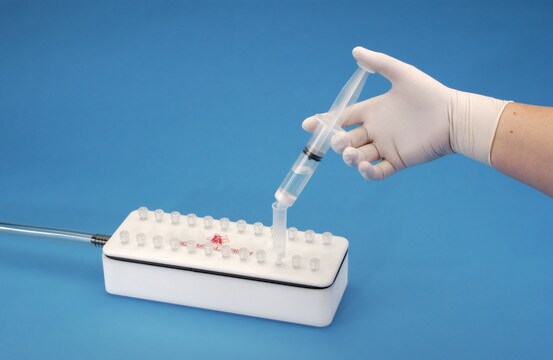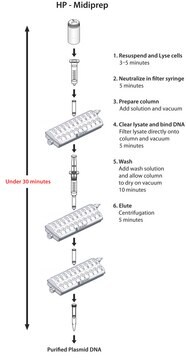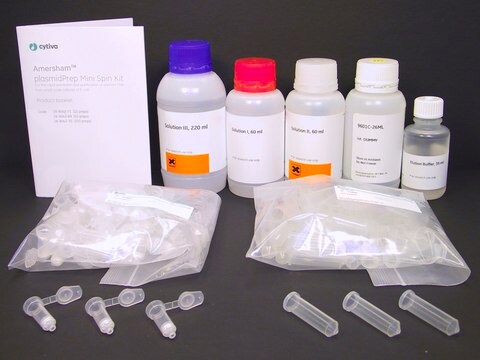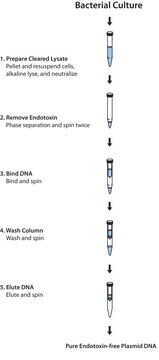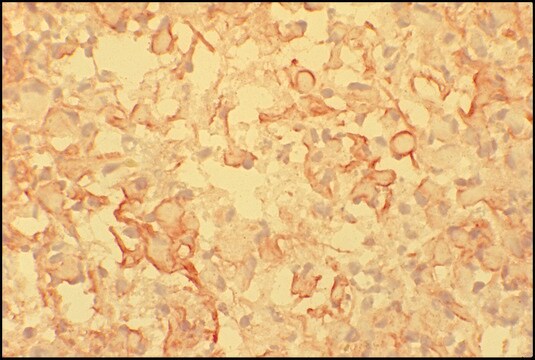Wszystkie zdjęcia(4)
Kluczowe dokumenty
03143422001
Roche
Zestaw Genopure Plasmid Maxi Kit
kit of for 10 isolations from 30 to 150 ml
Zaloguj sięWyświetlanie cen organizacyjnych i kontraktowych
About This Item
Kod UNSPSC:
41105500
NACRES:
NA.55
Polecane produkty
Poziom jakości
producent / nazwa handlowa
Roche
opakowanie
kit of for 10 isolations from 30 to 150 ml
Opis ogólny
Do przygotowania plazmidowego DNA na dużą skalę (maxi).
Zastosowanie
Zestaw Genopure Plasmid Maxi Kit przygotowuje plazmidowe DNA o jakości transfekcyjnej w dużych ilościach (do 500 μg plazmidu) z kultur bakteryjnych. Wyizolowany plazmid nadaje się do większości zastosowań biologii molekularnej:
- Transfekcja
- Southern blotting
- Sekwencjonowanie
- PCR/długi PCR
- Trawienie restrykcyjne
- Klonowanie
Cechy i korzyści
Zestaw Genopure Plasmid Maxi Kit przygotowuje wysoce oczyszczone plazmidowe DNA w dużych ilościach przy użyciu zmodyfikowanej metody lizy alkalicznej.
- Oszczędność czasu dzięki gotowym do użycia odczynnikom.
- Oczyszczanie wszystkich rozmiarów i typów plazmidów
- Równoległe przetwarzanie wielu próbek
- Eliminacja stosowania niebezpiecznych związków organicznych
- Uzyskanie plazmidowego DNA o wyższej czystości
Komponenty
- Suspension Buffer
- RNase A
- Lysis Buffer
- Neutralization Buffer
- Equilibration Buffer
- Wash Buffer
- Elution Buffer
- NucleoBond AX 500 Columns
- Folded Filters (240 mm diameter)
- Sealing Rings
Jakość
Plasmid DNA purified by this kit has been tested for restriction digestion; pUC 19 was isolated from transformed HB101 as described in the protocol. 1 μg of plasmid was completely digested with 1 U Msp I for 2 hours at +37°C, as shown by agarose gel analysis.
Plasmid recovery was tested with 250 μg purified plasmid. The recovery was >90%, with more than 80% in supercoiled form. The yield of plasmid DNA was determined by isolating pBS from DH5a cells. From 150 ml culture volume with a density of A600 between 3 and 6, >400 μg of plasmid DNA was obtained.
The purity (checked by the ratio of A260/A280) is 1.8 + 0.2.
RNA contamination was analyzed with 3 μg pBS purified with the standard procedure and checked by electrophoresis on an agarose gel. No RNA was detected.
The kit components have been tested for the absence of nucleases according to current quality control procedures.
Plasmid recovery was tested with 250 μg purified plasmid. The recovery was >90%, with more than 80% in supercoiled form. The yield of plasmid DNA was determined by isolating pBS from DH5a cells. From 150 ml culture volume with a density of A600 between 3 and 6, >400 μg of plasmid DNA was obtained.
The purity (checked by the ratio of A260/A280) is 1.8 + 0.2.
RNA contamination was analyzed with 3 μg pBS purified with the standard procedure and checked by electrophoresis on an agarose gel. No RNA was detected.
The kit components have been tested for the absence of nucleases according to current quality control procedures.
Uwaga dotycząca przygotowania
Procedura izolacji opiera się na zmodyfikowanym protokole lizy alkalicznej i można ją podzielić na następujące etapy: Bakterie są częściowo lizowane, co pozwala plazmidowemu DNA wydostać się ze ściany komórkowej do supernatantu. Większe chromosomalne DNA E. coli jest uwięzione w ścianie komórkowej. Lizat jest oczyszczany z resztek komórkowych przez filtrację lub wirowanie, a frakcja zawierająca plazmidowe DNA jest ładowana na wstępnie wyrównaną kolumnę. Ponieważ oczyszczony lizat jest nakładany na kolumnę w buforze o niskiej zawartości soli, plazmidowe DNA wiąże się z makroporowatym materiałem anionowymiennym w kolumnie. Zanieczyszczenia komórkowe są wymywane z kolumny za pomocą płukania o wysokiej zawartości soli. Na koniec plazmidowe DNA jest wymywane z kolumny. Odzyskane DNA jest wytrącane z eluatu w celu usunięcia soli i zagęszczenia plazmidu.
Komentarz do analizy
Próbka:
Hodowla E. coli zawierająca plazmid o wysokiej liczbie kopii: 30 do 150 ml hodowli bakteryjnej
Hodowla E. coli zawierająca plazmid o niskiej liczbie kopii: 100 do 500 ml hodowli bakteryjnej
Rozmiar plazmidu: Procedura izolacji jest odpowiednia dla wszystkich rozmiarów plazmidów. Uwaga: Lizaty większych konstruktów (do 100 kb) powinny być oczyszczane przez filtrację, a nie wirowanie, aby uniknąć ścinania plazmidu.
Wymagany czas: 75 minut (w tym filtracja lizatu)
Typowa wydajność:
Plazmid o wysokiej liczbie kopii: 3 do 5 μg/ml hodowli
Plazmid o niskiej liczbie kopii: 0,2 do 1 μg/ml hodowli
Czystość produktu: Wyizolowany plazmid DNA jest wolny od innych składników bakteryjnych, w tym RNA.
Hodowla E. coli zawierająca plazmid o wysokiej liczbie kopii: 30 do 150 ml hodowli bakteryjnej
Hodowla E. coli zawierająca plazmid o niskiej liczbie kopii: 100 do 500 ml hodowli bakteryjnej
Rozmiar plazmidu: Procedura izolacji jest odpowiednia dla wszystkich rozmiarów plazmidów. Uwaga: Lizaty większych konstruktów (do 100 kb) powinny być oczyszczane przez filtrację, a nie wirowanie, aby uniknąć ścinania plazmidu.
Wymagany czas: 75 minut (w tym filtracja lizatu)
Typowa wydajność:
Plazmid o wysokiej liczbie kopii: 3 do 5 μg/ml hodowli
Plazmid o niskiej liczbie kopii: 0,2 do 1 μg/ml hodowli
Czystość produktu: Wyizolowany plazmid DNA jest wolny od innych składników bakteryjnych, w tym RNA.
Inne uwagi
Wyłącznie do badań naukowych. Nie do użytku w procedurach diagnostycznych.
Ta strona może zawierać tekst przetłumaczony maszynowo.
Hasło ostrzegawcze
Danger
Zwroty wskazujące rodzaj zagrożenia
Zwroty wskazujące środki ostrożności
Klasyfikacja zagrożeń
Eye Dam. 1 - Flam. Liq. 3 - Met. Corr. 1 - Skin Corr. 1
Kod klasy składowania
3 - Flammable liquids
Klasa zagrożenia wodnego (WGK)
WGK 1
Temperatura zapłonu (°F)
100.4 °F
Temperatura zapłonu (°C)
38 °C
Wybierz jedną z najnowszych wersji:
Masz już ten produkt?
Dokumenty związane z niedawno zakupionymi produktami zostały zamieszczone w Bibliotece dokumentów.
Klienci oglądali również te produkty
Sharon Yunger et al.
Nature protocols, 8(2), 393-408 (2013-02-22)
Transcription kinetics of actively transcribing genes in vivo have generally been measured using tandem gene arrays. However, tandem arrays do not reflect the endogenous state of genome organization in which genes appear as single alleles. Here we present a robust
Vivian I Bonano et al.
Nature protocols, 2(9), 2166-2181 (2007-09-15)
Imaging technologies are influencing the way we study regulatory processes in vivo. Several recent reports use fluorescence minigenes to image alternative splicing events in living cells and animals. This type of reporter is being used to generate transgenic mice to
Haruka Sato et al.
eLife, 11 (2022-03-16)
Neuronal abundance and thickness of each cortical layer are specific to each area, but how this fundamental feature arises during development remains poorly understood. While some of area-specific features are controlled by intrinsic cues such as morphogens and transcription factors
Produkty
Chromatografia jonowymienna jest stosowana w zestawach Genopure Plasmid Midi Kit i Genopure Plasmid Maxi Kit.
Global Trade Item Number
| SKU | GTIN |
|---|---|
| 3143422001 | 4061837534263 |
Nasz zespół naukowców ma doświadczenie we wszystkich obszarach badań, w tym w naukach przyrodniczych, materiałoznawstwie, syntezie chemicznej, chromatografii, analityce i wielu innych dziedzinach.
Skontaktuj się z zespołem ds. pomocy technicznej